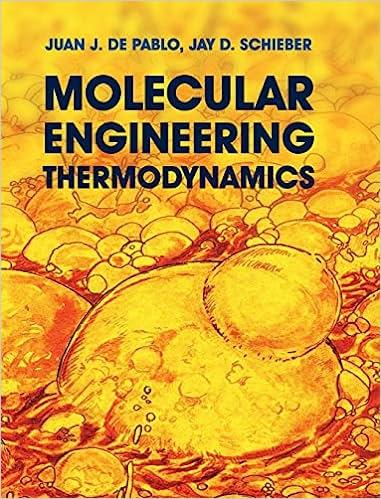I want to answer the questions in the attached picture
in the picture you can find a title called (Questions) , I need to solve all four questions mentioned below this title

1. Use MATLAB Version R2013b 2. Labs containing MATLAB: E1-S04 and E2-F09 Read the problem statement below before attempting to build your simulation: 1. Problem statement Consider the isothermal stirred-tank blending system in Figure 1.1 below. The tank is used to blend two streams (Feed 1 and Feed 2) composed of component A whose density is approximately 900kg/m3. The density does not change during mixing. The mass fraction of component A is denoted by x1 and x2. The total mass flow rate of Feed 1 and Feed 2 is represented by w1 and w2 respectively. Fe eed 2 1 | P a g e The dynamic model of the blending process is given by equation (1.1) and equation (1.2). dtdV=1(w1+w2w)dtdx=Vw1(x1x)+Vw2(x2x) The dynamic model is quite general and is based on only two assumptions: perfect mixing and constant density. The liquid volume of the tank is constant (V=2m3), which means that (dtdV=0) and the exit flow rate is equal to the sum of the inlet flow rates w=w1+w2 2. Questions: 1. Model the complete system in Simulink. The outputs of the system should be the mass fraction of component A. The inputs to the system are w1,w2,x1 and x2. For a step input of w1=500kg/min and w2=200kg/min, and feed compositions (mass fractions) of component Ax1=0.4 and x2=0.75, determine the steady state value of x. (show your result on a scope) (40 points) 2. In fact, the value of x1 shows continues variations with time. The variations in the process variable x1 can be represented as a sine wave signal with amplitude of 0.1 , a bias of 0.4 and a frequency of 0.5rad/s. What is the new response of the process output variable x ? (show your result on a scope) (20 points) Note: copy and paste the original Simulink model in your Simulink file and then add a sine wave on the second model 3. It is required to compare the two signals from Q1 and Q2. Show your results on one single scope. (10 points) 4. Knowing that x1 varies with time and x2 is constant. Explain two possible control strategies to maintain a steady state blending process with constant or near desired value of xsp (setpoint). For each strategy list the controlled variable, manipulated variable and disturbance variable. Which control strategy would you choose for this system? Explain your answer. (20 points) 5. Fill the Team Goals and Gantt Chart Tables and upload a peer review file (8 points) 6. Each student should submit a peer review file. The peer review file is available on Moodle. Upload a peer review file under Lab assignment 1 - Peer Review Moodle 1. Use MATLAB Version R2013b 2. Labs containing MATLAB: E1-S04 and E2-F09 Read the problem statement below before attempting to build your simulation: 1. Problem statement Consider the isothermal stirred-tank blending system in Figure 1.1 below. The tank is used to blend two streams (Feed 1 and Feed 2) composed of component A whose density is approximately 900kg/m3. The density does not change during mixing. The mass fraction of component A is denoted by x1 and x2. The total mass flow rate of Feed 1 and Feed 2 is represented by w1 and w2 respectively. Fe eed 2 1 | P a g e The dynamic model of the blending process is given by equation (1.1) and equation (1.2). dtdV=1(w1+w2w)dtdx=Vw1(x1x)+Vw2(x2x) The dynamic model is quite general and is based on only two assumptions: perfect mixing and constant density. The liquid volume of the tank is constant (V=2m3), which means that (dtdV=0) and the exit flow rate is equal to the sum of the inlet flow rates w=w1+w2 2. Questions: 1. Model the complete system in Simulink. The outputs of the system should be the mass fraction of component A. The inputs to the system are w1,w2,x1 and x2. For a step input of w1=500kg/min and w2=200kg/min, and feed compositions (mass fractions) of component Ax1=0.4 and x2=0.75, determine the steady state value of x. (show your result on a scope) (40 points) 2. In fact, the value of x1 shows continues variations with time. The variations in the process variable x1 can be represented as a sine wave signal with amplitude of 0.1 , a bias of 0.4 and a frequency of 0.5rad/s. What is the new response of the process output variable x ? (show your result on a scope) (20 points) Note: copy and paste the original Simulink model in your Simulink file and then add a sine wave on the second model 3. It is required to compare the two signals from Q1 and Q2. Show your results on one single scope. (10 points) 4. Knowing that x1 varies with time and x2 is constant. Explain two possible control strategies to maintain a steady state blending process with constant or near desired value of xsp (setpoint). For each strategy list the controlled variable, manipulated variable and disturbance variable. Which control strategy would you choose for this system? Explain your answer. (20 points) 5. Fill the Team Goals and Gantt Chart Tables and upload a peer review file (8 points) 6. Each student should submit a peer review file. The peer review file is available on Moodle. Upload a peer review file under Lab assignment 1 - Peer Review Moodle







